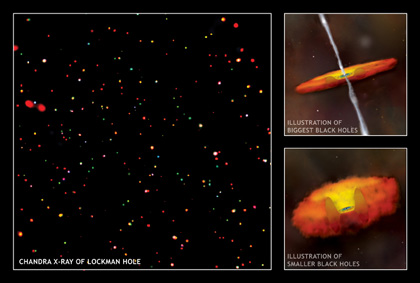February 15, 2005
NASA RELEASE: 05-046
The very largest black holes reach a certain point and then grow no more, according to the best survey to date of black holes made with NASA's Chandra X-ray Observatory. Scientists have also discovered many previously hidden black holes that are well below their weight limit.
These new results corroborate recent theoretical work about how black holes and galaxies grow. The biggest black holes, those with at least 100 million times the mass of the Sun, ate voraciously during the early Universe. Nearly all of them ran out of 'food' billions of years ago and went onto a forced starvation diet.
On the other hand, black holes between about 10 and 100 million solar masses followed a more controlled eating plan. Because they took smaller portions of their meals of gas and dust, they continue growing today.
"Our data show that some supermassive black holes seem to binge, while others prefer to graze", said Amy Barger of the University of Wisconsin in Madison and the University of Hawaii, lead author of the paper describing the results in the latest issue of The Astronomical Journal (Feb 2005). "We now understand better than ever before how supermassive black holes grow."
One revelation is that there is a strong connection between the growth of black holes and the birth of stars. Previously, astronomers had done careful studies of the birthrate of stars in galaxies, but didn't know as much about the black holes at their centers.
"These galaxies lose material into their central black holes at the same time that they make their stars," said Barger. "So whatever mechanism governs star formation in galaxies also governs black hole growth."
Astronomers have made an accurate census of both the biggest, active black holes in the distance, and the relatively smaller, calmer ones closer by. Now, for the first time, the ones in between have been counted properly.
"We need to have an accurate head count over time of all growing black holes if we ever hope to understand their habits, so to speak," co-author Richard Mushotzky of NASA's Goddard Space Flight Center in Greenbelt, Md.
Supermassive black holes themselves are invisible, but heated gas around them -- some of which will eventually fall into the black hole - produces copious amounts of radiation in the centers of galaxies as the black holes grow.
This study relied on the deepest X-ray images ever obtained, the Chandra Deep Fields North and South, plus a key wider-area survey of an area called the "Lockman Hole". The distances to the X-ray sources were determined by optical spectroscopic follow-up at the Keck 10-meter telescope on Mauna Kea in Hawaii, and show the black holes range from less than a billion to 12 billion light years away.
Since X-rays can penetrate the gas and dust that block optical and ultraviolet emission, the very long-exposure X-ray images are crucial to find black holes that otherwise would go unnoticed.
Chandra found that many of the black holes smaller than about 100 million Suns are buried under large amounts of dust and gas, which prevents detection of the optical light from the heated material near the black hole. The X-rays are more energetic and are able to burrow through this dust and gas. However, the largest of the black holes show little sign of obscuration by dust or gas. In a form of weight self-control, powerful winds generated by the black hole's feeding frenzy may have cleared out the remaining dust and gas.
Other aspects of black hole growth were uncovered. For example, the typical size of the galaxies undergoing supermassive black hole formation reduces with cosmic time. Such "cosmic downsizing" was previously observed for galaxies undergoing star formation. These results connect well with the observations of nearby galaxies, which find that the mass of a supermassive black hole is proportional to the mass of the central region of its host galaxy.
The other co-authors on the paper in the February 2005 issue of The Astronomical Journal were Len Cowie, Wei-Hao Wang, and Peter Capak (Institute for Astronomy, Univ. of Hawaii), Yuxuan Yang (GSFC and the Univ. of Maryland, College Park), and Aaron Steffen (Univ. of Wisconsin, Madison).
NASA's Marshall Space Flight Center, Huntsville, Ala., manages the Chandra program for NASA's Space Mission Directorate, Washington. Northrop Grumman of Redondo Beach, Calif., formerly TRW, Inc., was the prime development contractor for the observatory. The Smithsonian Astrophysical Observatory controls science and flight operations from the Chandra X-ray Center in Cambridge, Mass.
Additional information and images are available at:
MEDIA CONTACTS
Dolores Beasley
Headquarters, Washington
(Phone: 202/358-1753)
Steve Roy
Marshall Space Flight Center, Huntsville, Ala.
(Phone: 256/544-6535)
Megan Watzke
Chandra X-ray Observatory Center, Cambridge, Mass.
(Phone: 617/496-7998)








